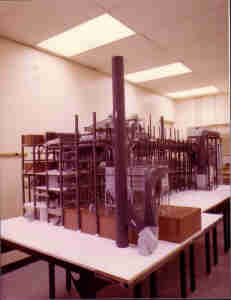







Fossil Fuel Plant 1

Fossil Fuel Plant 2








Diana Chace, art collector and industrial model builder, holds an interdisciplinary degree from Vassar College in Art History, Anthropology, and Theatre Set Design.
After college, Ms. Chace apprenticed at Architectural Models, Inc. in San Francisco, building plexi-glass presentation models, including studies for solar-paneled homes. She then worked in-house at HOK Architects and at Bullfield, Volkmann, Stockwell, making board and paper models of office buildings. At Bechtel Power she expanded her practice to include industrial design, where she refined her craft by constructing models of nuclear power and fossil fuel plants. She then worked for Chevron and Kaiser, continuing to build check-design models of large industrial sites, including a Mining and Metallurgical and an Orthene plant. Chace capped her fifteen-year model-building career by constructing one of the first architectural miniatures of George Lucas's Skywalker ranch.
During the late 1980's Chace turned her attention to art. Working closely with the Asian Art Museum, she became a formidable collector of Southeast Asian and Indonesian art and artifacts. On her frequent trips to Asia she also took photographs of pagodas, palaces, ritual tools, and people at work. These ethnographic studies became the basis of a film she made in 1990 that provides viewers of her collection with a moving cultural record of the sources of her interest in eastern art. Chace frequently gives public tours of her artworks, as well as informal talks.
Her dual career as an industrial model builder and Asian art collector has inspired Ms. Chace to produce a large-scale museum exhibition of industrial models of power technologies. Her hands-on experience with these models has given her a unique understanding for a significant period in the history of industrial design.
If you have knowledge of industrial models (nuclear, electric, fossil fuel, solar, wind, etc), particularly of large industrial sites built in the latter half of the twentieth century, please contact:
Diana Chace ~ dchace-at-comcast-dot-net